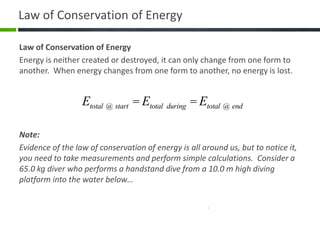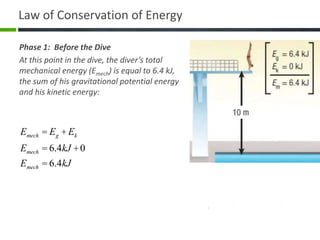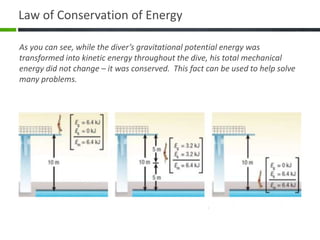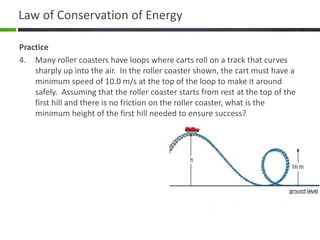Energy Conservation / Types of Potential Energy
- 1. SPH4C Unit #3 ŌĆō Energy Transformations Law of Conservation of Energy
- 2. Learning Goals and Success Criteria Today I will be able toŌĆ” ŌĆó Define the Law of Conservation of Energy and how it applies to energy changes, ŌĆó Describe how energy transformation occur between its different forms given a scenario, ŌĆó Use the Law of Conservation of Energy to solve related problems
- 3. Mechanical Energy Objects may possess kinetic energy only, gravitational potential energy only or a combination of both (mechanical energy). For example: ŌĆó A hockey puck sliding on the flat ice has kinetic energy only ŌĆó An acorn hanging in a tree has gravitational potential energy only ŌĆó A parachutist falling has both kinetic and gravitational potential energy
- 4. Types of Energy Mechanical Energy ŌĆó Sum of an objectŌĆÖs kinetic and gravitational potential energy ØÉĖØæÜØæÆØæÉŌäÄØæÄØæøØæ¢ØæÉØæÄØæÖ = ØÉĖØæś + ØÉĖØæö
- 5. Energy Transformations If you recall, there are many types of energy in the universe and the conservation of energy from one form to another is called an energy transformation. For example, in a microwave oven, electrical energy transforms into radiant energy (microwaves), which is then transformed into thermal energy in the food being cooked. Electrical energy ’āĀ radiant energy ’āĀ thermal energy Energy Transformation The change of energy from one form to another.
- 6. Energy Transformations People often wonder how much energy there is in the universe and whether we will eventually run out of energy. Scientists have studied energy and energy transformations and have arrived at some important generalizations. For example, they noticed that when one form of energy is transformed into another form (or forms) of energy, the quantity of one form is reduced by the same amount that the quantity of the other form (or forms) is increased. For example, a light bulb may transform 100 J of electrical energy into 5 J of radiant energy and 95 J of thermal energy. However, the total amount of energy has not changed. = + 100 J of electrical energy 95 J of thermal energy 5 J of radiant energy
- 7. This generalization, known as the law of conservation of energy, is stated as follows: Law of Conservation of Energy The total amount of energy in the universe is conserved. There is a certain total amount of energy in the universe, and this total never changes. New energy cannot be created out of nothing, and existing energy cannot disappear; the energy that exists can only be changed from one form into another. When an energy transformation occurs, no energy is lost. Law of Conservation of Energy
- 8. Law of Conservation of Energy Energy is neither created or destroyed, it can only change from one form to another. When energy changes from one form to another, no energy is lost. Note: Evidence of the law of conservation of energy is all around us, but to notice it, you need to take measurements and perform simple calculations. Consider a 65.0 kg diver who performs a handstand dive from a 10.0 m high diving platform into the water belowŌĆ” Law of Conservation of Energy Etotal @ start = Etotal during = Etotal @ end
- 9. Phase 1: Before the Dive The diver begins the dive in a handstand position on the platform of the diving tower. Since he is motionless, the diverŌĆÖs kinetic energy is equal to zero (Ek = 0), and his gravitational potential energy is calculated as follows: Law of Conservation of Energy Eg = mgh Eg = (65.0kg)(9.8N / kg)(10.0m) Eg = 6370 J or 6.4 kJ
- 10. Phase 1: Before the Dive At this point in the dive, the diverŌĆÖs total mechanical energy (Emech) is equal to 6.4 kJ, the sum of his gravitational potential energy and his kinetic energy: Law of Conservation of Energy Emech = Eg + Ek Emech = 6.4kJ + 0 Emech = 6.4kJ
- 11. Phase 2: At the Halfway Point At the halfway point, the diver is 5.0 m above the waterŌĆÖs surface (and is still accelerating at 9.8 m/s2 towards the water). At this point in the dive, the diverŌĆÖs gravitational potential may be calculated as follows: Law of Conservation of Energy Eg = mgh Eg = (65.0kg)(9.8N / kg)(5.0m) Eg = 3185 J or 3.2 kJ
- 12. Phase 2: At the Halfway Point At the halfway point, the diverŌĆÖs kinetic energy may be calculated as well. But first, his velocity at the halfway point must be calculated: Law of Conservation of Energy vf 2 = vi 2 + 2aDd where vi = 0 vf = 2(9.8m / s2 )(5.0m) vf = 9.899 m / s Ek = 1 2 mv2 Ek = 1 2 (65.0kg)(9.899m / s)2 Ek = 3185 J or 3.2 kJ
- 13. Phase 2: At the Halfway Point At the halfway point, the diverŌĆÖs total mechanical energy is still 6.4 kJ, the sum of his gravitational potential energy and his kinetic energy: Law of Conservation of Energy Emech = Eg + Ek Emech = 3.2kJ +3.2kJ Emech = 6.4kJ
- 14. Phase 3: At the WaterŌĆÖs Surface When the diver reaches the surface of the water, his height above the water is 0 m and so his gravitational potential energy is equal to zero (Eg = 0). His kinetic energy is calculated as follows: Law of Conservation of Energy vf 2 = vi 2 + 2aDd where vi = 0 vf = 2(9.8m / s2 )(10.0m) vf =14.0 m / s Ek = 1 2 mv2 Ek = 1 2 (65.0kg)(14.0m / s)2 Ek = 6370 J or 6.4 kJ
- 15. Phase 3: At the WaterŌĆÖs Surface At the waterŌĆÖs surface, the diverŌĆÖs total mechanical energy is still 6.4 kJ, the sum of his gravitational potential energy and his kinetic energy: Law of Conservation of Energy Emech = Eg + Ek Emech = 0+6.4kJ Emech = 6.4kJ
- 16. As you can see, while the diverŌĆÖs gravitational potential energy was transformed into kinetic energy throughout the dive, his total mechanical energy did not change ŌĆō it was conserved. This fact can be used to help solve many problems. Law of Conservation of Energy
- 17. Practice 1. A ball is dropped vertically from a height of 1.5 m; it bounces back to a height of 1.3 m. Does this violate the law of conservation of energy? Explain. No, it does not violate the law of conservation of energy. This is because some of the kinetic/elastic energy was transformed into other forms of energy such as sound/frictional. As a result, less energy was available to be transformed back into kinetic energy and thus gravitational potential energy. Law of Conservation of Energy
- 18. Practice 2. A 56 kg diver jumps off the end of a 7.5 m platform with an initial horizontal speed of 3.6 m/s. a) Determine the diverŌĆÖs total mechanical energy at the end of the platform relative to the surface of the water below. Law of Conservation of Energy
- 19. Practice 2. A 56 kg diver jumps off the end of a 7.5 m platform with an initial horizontal speed of 3.6 m/s. b) Apply the law of conservation of energy to determine the diverŌĆÖs speed at a height of 2.8 m above the water. Law of Conservation of Energy
- 20. Practice 2. A 56 kg diver jumps off the end of a 7.5 m platform with an initial horizontal speed of 3.6 m/s. c) Repeat (b) to find the maximum speed of the diver upon reaching the water. Law of Conservation of Energy
- 21. Practice 3. A 0.20 kg ball is thrown straight up from the edge of a 30.0 m tall building at a velocity of 22.0 m/s. The ball moves up to the maximum height and then falls to the ground at the base of the building. Use the law of conservation of energy to answer the following questions, assuming that the reference level for gravitational potential energy is ground level. a) What is the total energy of the ball at the start when it had a velocity of 22.0 m/s? Law of Conservation of Energy
- 22. Practice 3. A 0.20 kg ball is thrown straight up from the edge of a 30.0 m tall building at a velocity of 22.0 m/s. The ball moves up to the maximum height and then falls to the ground at the base of the building. Use the law of conservation of energy to answer the following questions, assuming that the reference level for gravitational potential energy is ground level. b) What is the velocity of the ball at the maximum height? Law of Conservation of Energy
- 23. Practice 3. A 0.20 kg ball is thrown straight up from the edge of a 30.0 m tall building at a velocity of 22.0 m/s. The ball moves up to the maximum height and then falls to the ground at the base of the building. Use the law of conservation of energy to answer the following questions, assuming that the reference level for gravitational potential energy is ground level. c) What is the maximum height of the ball? Law of Conservation of Energy
- 24. Practice 3. A 0.20 kg ball is thrown straight up from the edge of a 30.0 m tall building at a velocity of 22.0 m/s. The ball moves up to the maximum height and then falls to the ground at the base of the building. Use the law of conservation of energy to answer the following questions, assuming that the reference level for gravitational potential energy is ground level. d) What is the velocity of the ball when it hits the ground? Law of Conservation of Energy
- 25. Practice 4. Many roller coasters have loops where carts roll on a track that curves sharply up into the air. In the roller coaster shown, the cart must have a minimum speed of 10.0 m/s at the top of the loop to make it around safely. Assuming that the roller coaster starts from rest at the top of the first hill and there is no friction on the roller coaster, what is the minimum height of the first hill needed to ensure success? Law of Conservation of Energy
- 26. Homework Read: Pg. 152-153 Practice Problems: Pg. 153 #12

























